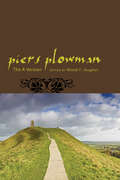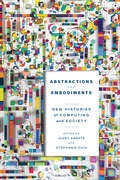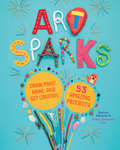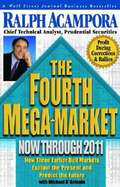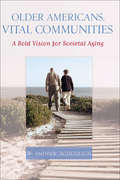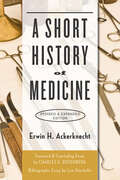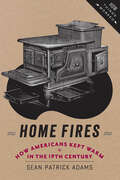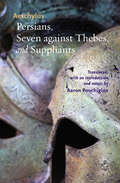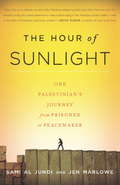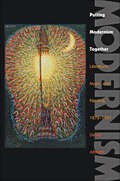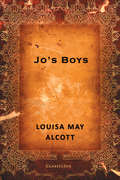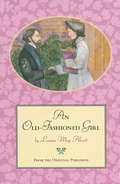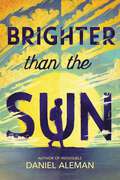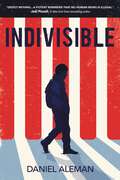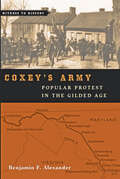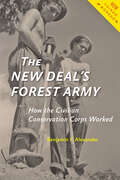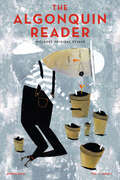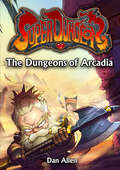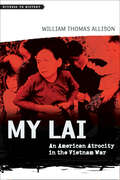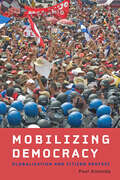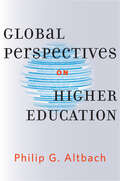- Table View
- List View
Piers Plowman: The A Version
by Mí 267 Eál F. VaughanThe fourteenth-century Piers Plowman is one of the most influential poems from the Age of Chaucer. Following the character Will on his quest for the true Christian life, the three dream narratives that make up this work address a number of pressing political, social, moral, and educational issues of the late Middle Ages. Míceál F. Vaughan presents a fresh edition of the A version, an earlier and shorter version of this great work.Unlike the B and C versions, there is no modern, affordable edition of the A version available. For the first time in decades, students and scholars of medieval literature now have access to this important work. Vaughan’s clean, uncluttered text is accompanied by ample glossing of difficult Middle English words. An expansive introduction, which includes a narrative summary of the poem, textual notes, detailed endnotes, and a select bibliography frame the text, making this edition ideal for classroom use.This is the first classroom edition of the A version since Thomas A. Knott and David C. Fowler’s celebrated 1952 publication. Based on an early-fifteenth-century manuscript from the University of Oxford’s Bodleian Library, Vaughan’s text offers a unique rendition of the poem, and it is the first modern edition not to attribute the poem to William Langland. By conservatively editing one important witness of Piers Plowman, Vaughan takes a new generation of students to an early version of this great medieval poem.
Abstractions and Embodiments: New Histories of Computing and Society (Studies in Computing and Culture)
by Janet Abbate Stephanie DickCutting-edge historians explore ideas, communities, and technologies around modern computing to explore how computers mediate social relations.Computers have been framed both as a mirror for the human mind and as an irreducible other that humanness is defined against, depending on different historical definitions of "humanness." They can serve both liberation and control because some people's freedom has historically been predicated on controlling others. Historians of computing return again and again to these contradictions, as they often reveal deeper structures.Using twin frameworks of abstraction and embodiment, a reformulation of the old mind-body dichotomy, this anthology examines how social relations are enacted in and through computing. The authors examining "Abstraction" revisit central concepts in computing, including "algorithm," "program," "clone," and "risk." In doing so, they demonstrate how the meanings of these terms reflect power relations and social identities. The section on "Embodiments" focuses on sensory aspects of using computers as well as the ways in which gender, race, and other identities have shaped the opportunities and embodied experiences of computer workers and users. Offering a rich and diverse set of studies in new areas, the book explores such disparate themes as disability, the influence of the punk movement, working mothers as technical innovators, and gaming behind the Iron Curtain. Abstractions and Embodiments reimagines computing history by questioning canonical interpretations, foregrounding new actors and contexts, and highlighting neglected aspects of computing as an embodied experience. It makes the profound case that both technology and the body are culturally shaped and that there can be no clear distinction between social, intellectual, and technical aspects of computing. Contributors: Janet Abbate, Marc Aidinoff, Troy Kaighin Astarte, Ekaterina Babinsteva, André Brock, Maarten Bullynck, Jiahui Chan, Gerardo Con Diaz, Liesbeth De Mol, Stephanie Dick, Kelcey Gibbons, Elyse Graham, Michael J. Halvorson, Mar Hicks, Scott Kushner, Xiaochang Li, Zachary Loeb, Lisa Nakamura, Tiffany Nichols, Laine Nooney, Elizabeth Petrick, Cierra Robson, Hallam Stevens, Jaroslav Švelch
Art Sparks: Draw, Paint, Make, and Get Creative with 53 Amazing Projects!
by Marion Abrams Hilary Emerson LayThis lively, colorful compendium of arts and crafts for a new generation of kids features projects specially designed to spark creativity, invite self-expression, and nurture self-confidence. From finger puppets to fabric flags to shrink art, each activity uses inexpensive materials and can be crafted in less than 90 minutes.
The Fourth Mega-Market, Now Through 2011: How Three Earlier Bull Markets Explain the Present and Predict the Future
by Ralph Acampora Michael D'AngeloA proven leader in the financial world explains the current bull market--and how to profit from it--by comparing it to the great bull markets of the past.Were you surprised by Wall Street's incredible performance over the past few years? Ralph Acampora wasn't. In fact, Acampora, Prudential's top technical analyst, predicted the current bullish trend--and helped countless clients profit from it. Now you can too.Acampora coined the term mega-market to describe a bull market that lasts a minimum of ten years and a maximum of eighteen years with Dow gains of between 400% and 500%. In The Fourth Mega-Market, Acampora helps readers take advantage of the staggering performance of the current market by showing its similarities with the three previous mega-markets in American history. In an entertaining and straight-forward style, and with a wealth of informative charts and graphs, he helps readers recognize patterns that can explain market performance, showing how to use technical analysis to "hear the voices" of the market. He offers valuable tips, such as how to spot and protect yourself from a correction; how psychology and politics influence the market; and how to analyze the performance of various market segments. Finally, he makes exciting predictions on just where the market will go before it ends and how it will get there, giving specific recommendations. While today's information overload keeps us on the edge of our seats, scanning the numbers for subtle clues as to the market's next seismic shift, Ralph Acampora shows us the value of a larger perspective, one that not only explains today's mega-market, but also shows us how to keep investing our money wisely and ride high on the current wave.
Older Americans, Vital Communities: A Bold Vision for Societal Aging
by W. Andrew AchenbaumThis thought-provoking work grapples with the vast range of issues associated with the aging population and challenges people of all ages to think more boldly and more creatively about the relationship between older Americans and their communities. W. Andrew Achenbaum begins by exploring the demographics of our aging society and its effect on employment and markets, education, health care, religion, and political action. Drawing on history, literature, and philosophy, Achenbaum focuses on the way health care and increases in life expectancy have transformed late life from a phase characterized by illness, frailty, and debility to one of vitality, productivity, and spirituality. He shows how this transformation of aging is beginning to be felt in programs and policies for aging persons, as communities focus more effort on lifelong learning and extensive civic engagement. Concerned that his own undergraduate students are too focused on the immediate future, Achenbaum encourages young people to consider their place in life's social and chronological trajectory. He calls on baby boomers to create institutional structures that promote productive, vital growth for the common good, and he invites people of all ages to think more boldly about what they will do with the long lives ahead of them.
A Short History of Medicine
by Erwin H. Ackerknecht Lisa Haushofer.Erwin H. Ackerknecht;€™s A Short History of Medicine is a concise narrative, long appreciated by students in the history of medicine, medical students, historians, and medical professionals as well as all those seeking to understand the history of medicine.Covering the broad sweep of discoveries from parasitic worms to bacilli and x-rays, and highlighting physicians and scientists from Hippocrates and Galen to Pasteur, Koch, and Roentgen, Ackerknecht narrates Western and Eastern civilization;€™s work at identifying and curing disease. He follows these discoveries from the library to the bedside, hospital, and laboratory, illuminating how basic biological sciences interacted with clinical practice over time. But his story is more than one of laudable scientific and therapeutic achievement. Ackerknecht also points toward the social, ecological, economic, and political conditions that shape the incidence of disease. Improvements in health, Ackerknecht argues, depend on more than laboratory knowledge: they also require that we improve the lives of ordinary men and women by altering social conditions such as poverty and hunger.This revised and expanded edition includes a new foreword and concluding biographical essay by Charles E. Rosenberg, Ackerknecht;€™s former student and a distinguished historian of medicine. A new bibliographic essay by Lisa Haushofer explores recent scholarship in the history of medicine.
A Short History of Medicine
by Erwin H. Ackerknecht Lisa Haushofer.Erwin H. Ackerknecht;€™s A Short History of Medicine is a concise narrative, long appreciated by students in the history of medicine, medical students, historians, and medical professionals as well as all those seeking to understand the history of medicine.Covering the broad sweep of discoveries from parasitic worms to bacilli and x-rays, and highlighting physicians and scientists from Hippocrates and Galen to Pasteur, Koch, and Roentgen, Ackerknecht narrates Western and Eastern civilization;€™s work at identifying and curing disease. He follows these discoveries from the library to the bedside, hospital, and laboratory, illuminating how basic biological sciences interacted with clinical practice over time. But his story is more than one of laudable scientific and therapeutic achievement. Ackerknecht also points toward the social, ecological, economic, and political conditions that shape the incidence of disease. Improvements in health, Ackerknecht argues, depend on more than laboratory knowledge: they also require that we improve the lives of ordinary men and women by altering social conditions such as poverty and hunger.This revised and expanded edition includes a new foreword and concluding biographical essay by Charles E. Rosenberg, Ackerknecht;€™s former student and a distinguished historian of medicine. A new bibliographic essay by Lisa Haushofer explores recent scholarship in the history of medicine.
Home Fires: How Americans Kept Warm in the Nineteenth Century (How Things Worked)
by Sean Patrick AdamsHome Fires tells the fascinating story of how changes in home heating over the nineteenth century spurred the growth of networks that helped remake American society. Sean Patrick Adams reconstructs the ways in which the "industrial hearth" appeared in American cities, the methods that entrepreneurs in home heating markets used to convince consumers that their product designs and fuel choices were superior, and how elite, middle-class, and poor Americans responded to these overtures.Adams depicts the problem of dwindling supplies of firewood and the search for alternatives; the hazards of cutting, digging, and drilling in the name of home heating; the trouble and expense of moving materials from place to place; the rise of steam power; the growth of an industrial economy; and questions of economic efficiency, at both the individual household and the regional level. Home Fires makes it clear that debates over energy sources, energy policy, and company profit margins have been around a long time.The challenge of staying warm in the industrializing North becomes a window into the complex world of energy transitions, economic change, and emerging consumerism. Readers will understand the struggles of urban families as they sought to adapt to the ever-changing nineteenth-century industrial landscape. This perspective allows a unique view of the development of an industrial society not just from the ground up but from the hearth up.
Home Fires: How Americans Kept Warm in the Nineteenth Century (How Things Worked)
by Sean Patrick AdamsHome Fires tells the fascinating story of how changes in home heating over the nineteenth century spurred the growth of networks that helped remake American society. Sean Patrick Adams reconstructs the ways in which the "industrial hearth" appeared in American cities, the methods that entrepreneurs in home heating markets used to convince consumers that their product designs and fuel choices were superior, and how elite, middle-class, and poor Americans responded to these overtures.Adams depicts the problem of dwindling supplies of firewood and the search for alternatives; the hazards of cutting, digging, and drilling in the name of home heating; the trouble and expense of moving materials from place to place; the rise of steam power; the growth of an industrial economy; and questions of economic efficiency, at both the individual household and the regional level. Home Fires makes it clear that debates over energy sources, energy policy, and company profit margins have been around a long time.The challenge of staying warm in the industrializing North becomes a window into the complex world of energy transitions, economic change, and emerging consumerism. Readers will understand the struggles of urban families as they sought to adapt to the ever-changing nineteenth-century industrial landscape. This perspective allows a unique view of the development of an industrial society not just from the ground up but from the hearth up.
Persians, Seven against Thebes, and Suppliants (Johns Hopkins New Translations from Antiquity)
by AeschylusAaron Poochigian’s new translations of Aeschylus’s earliest extant plays provide the clearest rendering yet of their formal structure. The distinction between spoken and sung rhythms is as sharp as it is in the source texts, and for the first time readers in English can fully grasp the balanced, harmonious arrangement of choral odes. The importance of these works to the history of drama and tragedy and to the history of classical literature is beyond question, and their themes of military hubris and foreign versus native are deeply relevant today. Persians offers a surprisingly sympathetic portrayal of the Athenians’ most hated enemy; in Seven against Thebes Argive invaders, though no less Greek than the Thebans themselves, are portrayed as barbarians; and in Suppliants the city of Argos is called upon to protect Egyptian refugees. Based on textual evidence and the archaeological remains of the Theater of Dionysus at Athens, Poochigian’s introductory overview of stage properties and accompanying stage directions allow readers to experience the plays as they were performed in their own time. He is most careful in his translations of the plays’ choral odes. Instead of rendering them with little or no form, Poochigian has preserved the comprehensive structures Aeschylus himself employed. Readers are thus able to recognize Aeschylus as a master of poetry as well as of drama. Poochigian’s translations are the most accurate renditions of the poetry and dramaturgy of the original works available. Intended to be both read as literature and performed as plays, these translations are lucid and readable, while remaining staunchly faithful to the texts.
The Hour of Sunlight: One Palestinian's Journey from Prisoner to Peacemaker
by Sami al Jundi Jen MarloweAs a teenager in Palestine, Sami al Jundi had one ambition: overthrowing Israeli occupation. With two friends, he began to build a bomb to use against the police. But when it exploded prematurely, killing one of his friends, al Jundi was caught and sentenced to ten years in prison. It was in an Israeli jail that his unlikely transformation began. Al Jundi was welcomed into a highly organized, democratic community of political prisoners who required that members of their cell read, engage in political discourse on topics ranging from global revolutions to the precepts of nonviolent protest and revolution.Al Jundi left prison still determined to fight for his people's rights-but with a very different notion of how to undertake that struggle. He cofounded the Middle East program of Seeds of Peace Center for Coexistence, which brings together Palestinian and Israeli youth.Marked by honesty and compassion for Palestinians and Israelis alike, The Hour of Sunlight illuminates the Palestinian experience through the story of one man's struggle for peace.
The Hour of Sunlight: One Palestinian's Journey from Prisoner to Peacemaker
by Sami al Jundi Jen MarloweAs a teenager in Palestine, Sami al Jundi had one ambition: overthrowing Israeli occupation. With two friends, he began to build a bomb to use against the police. But when it exploded prematurely, killing one of his friends, al Jundi was caught and sentenced to ten years in prison. It was in an Israeli jail that his unlikely transformation began. Al Jundi was welcomed into a highly organized, democratic community of political prisoners who required that members of their cell read, engage in political discourse on topics ranging from global revolutions to the precepts of nonviolent protest and revolution. Al Jundi left prison still determined to fight for his people's rights -- but with a very different notion of how to undertake that struggle. He cofounded the Middle East program of Seeds of Peace Center for Coexistence, which brings together Palestinian and Israeli youth. Marked by honesty and compassion for Palestinians and Israelis alike, The Hour of Sunlight illuminates the Palestinian experience through the story of one man's struggle for peace.
Putting Modernism Together: Literature, Music, and Painting, 1872–1927 (Hopkins Studies in Modernism)
by Daniel AlbrightHow do you rationally connect the diverse literature, music, and painting of an age? Throughout the modernist era�which began roughly in 1872 with the Franco-Prussian War, climaxed with the Great War, and ended with a third catastrophe, the Great Depression�there was a special belligerence to this question. It was a cultural period that envisioned many different models of itself: to the Cubists, it looked like a vast jigsaw puzzle; to the Expressionists, it resembled a convulsive body; to the Dadaists, it brought to mind a heap of junk following an explosion. In Putting Modernism Together, Daniel Albright searches for the center of the modernist movement by assessing these various artistic models, exploring how they generated a stunning range of creative work that was nonetheless wound together aesthetically, and sorting out the cultural assumptions that made each philosophical system attractive. Emerging from Albright's lectures for a popular Harvard University course of the same name, the book investigates different methodologies for comparing the evolution and congruence of artistic movements by studying simultaneous developments that occurred during particularly key modernist years. What does it mean, Albright asks, that Joseph Conrad's Heart of Darkness, published in 1899, appeared at the same time as Claude Debussy's Nocturnes�beyond the fact that the word "Impressionist" has been used to describe each work? Why, in 1912, did the composer Arnold Schoenberg and the painter Vassily Kandinsky feel such striking artistic kinship? And how can we make sense of a movement, fragmented by isms, that looked for value in all sorts of under- or ill-valued places, including evil (Baudelaire), dung heaps (Chekhov), noise (Russolo), obscenity (Lawrence), and triviality (Satie)? Throughout Putting Modernism Together, Albright argues that human culture can best be understood as a growth-pattern or ramifying of artistic, intellectual, and political action. Going beyond merely explaining how the artists in these genres achieved their peculiar effects, he presents challenging new analyses of telling craft details which help students and scholars come to know more fully this bold age of aesthetic extremism.
Jo's Boys: And How They Turned Out
by Louisa AlcottThe little men of Plumfield are now grown and making their ways in the world. But even as their pursuits take them far from home, "Mother" Jo March continues to play an inspiring and steadying role in their lives.Through adventures great and small, Tommy, Emil, Demi, Nat, Dan, and the rest of the March children experience love and loss, but never forget the lessons they learned from Meg, Jo, and Amy March—the little women who have guided them from childhood.Be it mystery, romance, drama, comedy, politics, or history, great literature stands the test of time. ClassicJoe proudly brings literary classics to today's digital readers, connecting those who love to read with authors whose work continues to get people talking. Look for other fiction and non-fiction classics from ClassicJoe.
An Old-Fashioned Girl: Large Print
by Louisa May AlcottPolly's friendship with the wealthy Shaws of Boston helps them to build a new life and teaches her the truth about the relationship between happiness and riches.
Brighter Than the Sun
by Daniel AlemanThis timely and thought-provoking story about a teen girl shouldering impossibly large responsibilities and ultimately learning that she doesn&’t have to do it alone is the perfect follow-up to Daniel Aleman's award-winning debut novel, Indivisible. Every morning, sixteen-year-old Sol wakes up at the break of dawn in her hometown of Tijuana, Mexico and makes the trip across the border to go to school in the United States. Though the commute is exhausting, this is the best way to achieve her dream: becoming the first person in her family to go to college. When her family&’s restaurant starts struggling, Sol must find a part-time job in San Diego to help her dad put food on the table and pay the bills. But her complicated school and work schedules on the US side of the border mean moving in with her best friend and leaving her family behind. With her life divided by an international border, Sol must come to terms with the loneliness she hides, the pressure she feels to succeed for her family, and the fact that the future she once dreamt of is starting to seem unattainable. Mostly, she&’ll have to grapple with a secret she&’s kept even from herself: that maybe she&’s relieved to have escaped her difficult home life, and a part of her may never want to return.
Indivisible
by Daniel AlemanThis timely, moving debut novel follows a teen's efforts to keep his family together as his parents face deportation.Mateo Garcia and his younger sister, Sophie, have been taught to fear one word for as long as they can remember: deportation. Over the past few years, however, the fear that their undocumented immigrant parents could be sent back to Mexico has started to fade. Ma and Pa have been in the United States for so long, they have American-born children, and they're hard workers and good neighbors. When Mateo returns from school one day to find that his parents have been taken by ICE, he realizes that his family's worst nightmare has become a reality. With his parents' fate and his own future hanging in the balance, Mateo must figure out who he is and what he is capable of, even as he's forced to question what it means to be an American.Daniel Aleman's Indivisible is a remarkable story—both powerful in its explorations of immigration in America and deeply intimate in its portrait of a teen boy driven by his fierce, protective love for his parents and his sister.
Coxey's Army: Popular Protest in the Gilded Age (Witness to History)
by Benjamin F. AlexanderIn 1893, after a major British bank failure, a run on U.S. gold reserves, and a late-June stock-market crash, America was in the throes of a serious economic depression. Unemployment rose, foreclosures climbed, and popular unrest mounted. By the following spring, businessman and Populist agitator Jacob S. Coxey was fed up with government inactivity in the face of the crisis. With the help of eccentric showman Carl Browne, he led a group of several hundred unemployed wage earners, small farmers, and crossroads merchants on a march from Massillon, Ohio, to Washington, D.C., to present a "petition in boots" for government-financed jobs building and repairing the nation’s roads. On May 1, the Coxeyites descended on the center of government, where Coxey attempted to deliver a speech on the Capitol steps. The police attacked, a melee ensued, and Coxey and Browne spent a month in jail. Meanwhile, other Coxey-inspired contingents were on their way east from places as far away as San Francisco and Portland. Some of them even hijacked trains along the way. Who was Coxey, and what motivated himâ€�along with the angry marchers who joined his cause? What did other Americans think of the protesters? Was there ever any chance that the protesters’ demands would be met? Where did the agitators fit in with the politics of their day, and how did their actions jibe with the other labor-related protests happening that year? In this concise and gripping narrative, Benjamin F. Alexander contextualizes the march by vividly describing the misery wrought by the Panic of ’93. Alexander brings both Coxey and his fellow leaders to life, along with the reporters and spies who traveled with them and the diverse group of captivated newspaper readers who followed the progress of the marches and train heists.Coxey’s Army explains how the demands of the Coxeyitesâ€�far from being the wild schemes of a small group of cranksâ€�fit into a larger history of economic theories that received serious attention long before and long after the Coxey march. Despite running a gauntlet of ridicule, the marchers laid down a rough outline of what, some forty years later, emerged as the New Deal.
The New Deal's Forest Army: How the Civilian Conservation Corps Worked (How Things Worked)
by Benjamin F. AlexanderPropelled by the unprecedented poverty of the Great Depression, President Franklin D. Roosevelt established an array of massive public works programs designed to provide direct relief to America;€™s poor and unemployed. The New Deal;€™s most tangible legacy may be the Civilian Conservation Corps;€™s network of parks, national forests, scenic roadways, and picnic shelters that still mark the country;€™s landscape. CCC enrollees, most of them unmarried young men, lived in camps run by the Army and worked hard for wages (most of which they had to send home to their families) to preserve America;€™s natural treasures. In The New Deal;€™s Forest Army, Benjamin F. Alexander chronicles how the corps came about, the process applicants went through to get in, and what jobs they actually did. He also explains how the camps and the work sites were run, how enrollees spent their leisure time, and how World War II brought the CCC to its end. Connecting the story of the CCC with the Roosevelt administration;€™s larger initiatives, Alexander describes how FDR;€™s policies constituted a mixed blessing for African Americans who, even while singled out for harsh treatment, benefited enough from the New Deal to become an increasingly strong part of the electorate behind the Democratic Party. The CCC was the only large-scale employment program whose existence FDR foreshadowed in speeches during the 1932 campaign;¢;‚¬;€?and the dearest to his heart throughout the decade that it lasted. Alexander reveals how the work itself left a lasting imprint on the country;€™s terrain as the enrollees planted trees, fought forest fires, landscaped public parks, restored historic battlegrounds, and constructed dams and terraces to prevent floods. A uniquely detailed exploration of life in the CCC, The New Deal;€™s Forest Army compellingly demonstrates how one New Deal program changed America and gave birth to both contemporary forestry and the modern environmental movement.
The New Deal's Forest Army: How the Civilian Conservation Corps Worked (How Things Worked)
by Benjamin F. AlexanderPropelled by the unprecedented poverty of the Great Depression, President Franklin D. Roosevelt established an array of massive public works programs designed to provide direct relief to America;€™s poor and unemployed. The New Deal;€™s most tangible legacy may be the Civilian Conservation Corps;€™s network of parks, national forests, scenic roadways, and picnic shelters that still mark the country;€™s landscape. CCC enrollees, most of them unmarried young men, lived in camps run by the Army and worked hard for wages (most of which they had to send home to their families) to preserve America;€™s natural treasures. In The New Deal;€™s Forest Army, Benjamin F. Alexander chronicles how the corps came about, the process applicants went through to get in, and what jobs they actually did. He also explains how the camps and the work sites were run, how enrollees spent their leisure time, and how World War II brought the CCC to its end. Connecting the story of the CCC with the Roosevelt administration;€™s larger initiatives, Alexander describes how FDR;€™s policies constituted a mixed blessing for African Americans who, even while singled out for harsh treatment, benefited enough from the New Deal to become an increasingly strong part of the electorate behind the Democratic Party. The CCC was the only large-scale employment program whose existence FDR foreshadowed in speeches during the 1932 campaign;¢;‚¬;€?and the dearest to his heart throughout the decade that it lasted. Alexander reveals how the work itself left a lasting imprint on the country;€™s terrain as the enrollees planted trees, fought forest fires, landscaped public parks, restored historic battlegrounds, and constructed dams and terraces to prevent floods. A uniquely detailed exploration of life in the CCC, The New Deal;€™s Forest Army compellingly demonstrates how one New Deal program changed America and gave birth to both contemporary forestry and the modern environmental movement.
The Algonquin Reader: Spring 2018
by Algonquin Books of Chapel HillGet an inside look at Algonquin&’s outstanding forthcoming fiction with the Spring 2018 Algonquin Reader. Discover the inspiration behind each book through an original essay by the author. Then enjoy a short preview of each novel. The books featured in this issue are:The Optimistic Decade by Heather Abel On Sale May 2018Dreadful Young Ladies and Other Stories by Kelly Barnhill On Sale February 2018Lawn Boy by Jonathan Evison On Sale April 2018Remind Me Again What Happened by Joanna Luloff On Sale June 2018The Price of the Haircut: Stories by Brock Clarke On Sale March 2018Southernmost by Silas House On Sale June 2018 Cover illustration by Mark Hoffmann.
The Dungeons of Arcadia
by Dan AllenBased on the board game Super Dungeon Explore, this hilarious children's series follows the adventures of questing heroes as they take down evil and rescue the missing princesses of Crystalia.
My Lai: An American Atrocity in the Vietnam War (Witness to History)
by William Thomas AllisonOn March 16, 1968, American soldiers killed as many as five hundred Vietnamese men, women, and children in a village near the South China Sea. In My Lai William Thomas Allison explores and evaluates the significance of this horrific event. How could such a thing have happened? Who (or what) should be held accountable? How do we remember this atrocity and try to apply its lessons, if any? My Lai has fixed the attention of Americans of various political stripes for more than forty years. The breadth of writing on the massacre, from news reports to scholarly accounts, highlights the difficulty of establishing fact and motive in an incident during which confusion, prejudice, and self-preservation overwhelmed the troops. Son of a Marine veteran of the Vietnam War—and aware that the generation who lived through the incident is aging—Allison seeks to ensure that our collective memory of this shameful episode does not fade.Well written and accessible, Allison’s book provides a clear narrative of this historic moment and offers suggestions for how to come to terms with its aftermath.
Mobilizing Democracy: Globalization and Citizen Protest (Themes in Global Social Change)
by Paul AlmeidaPaul Almeida’s comparative study of the largest social movement campaigns that existed between 1980 and 2013 in every Central American country (Costa Rica, El Salvador, Guatemala, Honduras, Nicaragua, and Panama) provides a granular examination of the forces that spark mass mobilizations against state economic policy, whether those factors are electricity rate hikes or water and health care privatization. Many scholars have explained connections between global economic changes and local economic conditions, but most of the research has remained at the macro level. Mobilizing Democracy contributes to our knowledge about the protest groups "on the ground" and what makes some localities successful at mobilizing and others less successful. His work enhances our understanding of what ingredients contribute to effective protest movements as well as how multiple protagonistsâ€�labor unions, students, teachers, indigenous groups, nongovernmental organizations, women’s groups, environmental organizations, and oppositional political partiesâ€�coalesce to make protest more likely to win major concessions.Based on extensive field research, archival data of thousands of protest events, and interviews with dozens of Central American activists, Mobilizing Democracy brings the international consequences of privatization, trade liberalization, and welfare-state downsizing in the global South into focus and shows how persistent activism and network building are reactivated in these social movements. Almeida enables our comprehension of global and local politics and policy by answering the question, "If all politics is local, then how do the politics of globalization manifest themselves?" Detailed graphs and maps provide a synthesis of the quantitative and qualitative data in this important study. Written in clear, accessible prose, this book will be invaluable for students and scholars in the fields of political science, social movements, anthropology, Latin American studies, and labor studies.
Global Perspectives on Higher Education: A Global Revol (Global Perspectives On Higher Education Ser. #2)
by Philip G. AltbachOver the past half-century, globalization has had a profound impact on postsecondary education. The twin forces of mass higher education and the global knowledge economy have driven an unprecedented transformation. These fundamental changes have pulled in opposite directions: one pushes for wider access and accompanying challenges of quality, the other toward exclusive, "world class" research-oriented universities. In Global Perspectives on Higher Education, renowned higher education scholar Philip G. Altbach offers a wide-ranging perspective on the implications of these key forces and explores how they influence academe everywhere. Altbach begins with a discussion of the global trends that increasingly affect higher education, including the implications of mass enrollments, the logic of mass higher education systems around the world, and specific challenges facing Brazil, Russia, India, and China. He considers the numerous implications of globalization, including the worldwide use of the English language, university cross-border initiatives, the role of research universities in developing countries, the impact of the West on Asian universities, and the expansion of private higher education.Provocative and wide-ranging, Global Perspectives on Higher Education considers how the international exchange of ideas, students, and scholars has fundamentally altered higher education.
